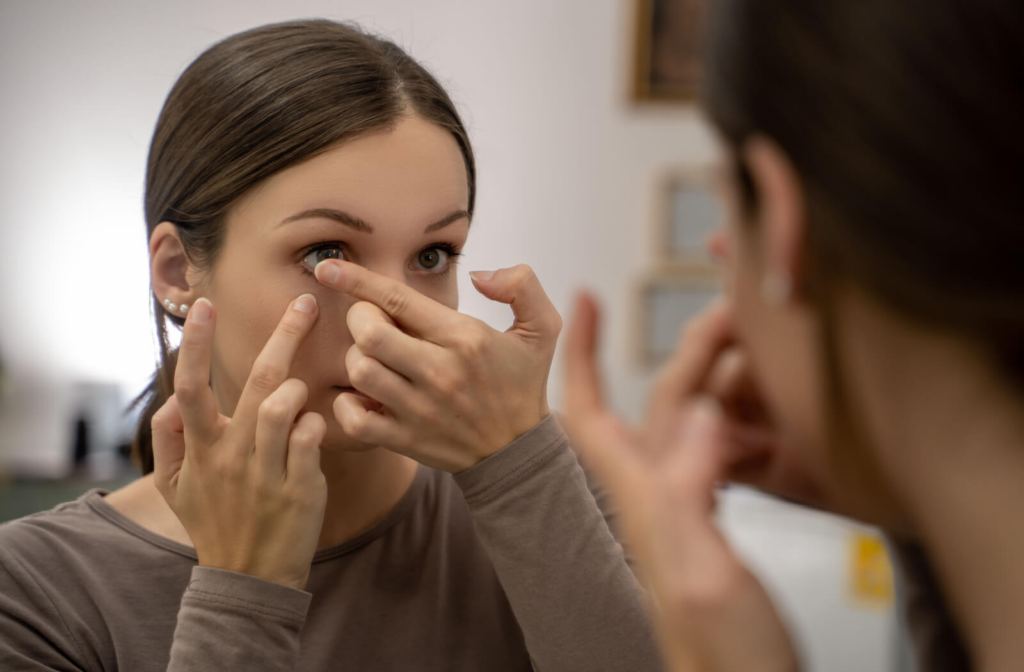Contact lenses have come a long way. Today, improving your vision with contact lenses can be convenient, flexible, and offers a more natural look than eyeglasses.
Once you have a contact lens exam and your eye doctor confirms you’re a candidate for contacts, a fitting can help determine the right lens for your needs. After your first contact lens exam, you should have another exam and contact lens fitting each year.
What Happens During a Contact Lens Exam?
A contact lens exam is different from your regular eye exam. However, you will probably need a comprehensive eye exam before having a contact lens exam to assess your eye health.
A contact lens exam includes the following tests:
- Keratometry or corneal topography: Takes cornea measurements so your eye doctor can determine the proper curve and size of your contact lenses. It also helps with corneal astigmatism measurement and assessment of a refractive error.
- Pupil and iris measurements: To determine your contact lens size. They also help if you need to wear rigid gas-permeable lenses.
- Tear film evaluation: If dry eye is a concern, we may evaluate your tear film to determine if you need special contact lenses for dry eyes.
What Is a Contact Lens Fitting?
A contact lens fitting is a procedure your eye doctor conducts to determine the appropriate contact lens prescription and fit for your eyes. They do this by using the measurements taken of your eye shape during your contact lens exam.
For the contact lens fitting, your eye doctor looks at the curvature and size of the cornea (clear front part of the eye). Based on these measurements, they can recommend the best type of contact lenses for your prescription and lifestyle.
How Often Should You Get a Contact Lens Fitting?
When you choose your first pair of contact lenses, you may receive a trial pair that requires follow-up visits. If everything goes well, you’re all set. However, sometimes it can take a few tries to find the size and brand that works for you.
The frequency of contact lens fittings can vary depending on several factors, such as:
- The type of lenses you use
- Your eye health
- Your prescription
But typically, you should have a contact lens fitting at least once a year so your eye doctor can evaluate the fit of your current contact lenses. Annual fittings can keep your contact lens prescription up-to-date. In California, contact lens prescriptions are valid for 1–2 years. Your contact lens prescription can include the following information:
- Contact lens brand
- Base curve or curvature of the optical zone of the lenses
- The lens diameter
- The expiration date for purchasing replacement lenses
Your lifestyle may change, and the curvature and shape of your cornea can change over time, thus affecting the way your contact lenses fit and how well you see. Additionally, your eye doctor can detect changes in your eye health during a contact lens exam and fitting and recommend appropriate treatment if necessary.
For more complex prescriptions or specialty contact lenses, such as multifocal, toric, or scleral lenses, you may need to get a contact lens exam and fitting more frequently. These lenses require precise measurements and fittings to help you achieve optimal vision correction. Your eye doctor can advise you on the appropriate frequency based on your needs.

Signs That You Need a Contact Lens Fitting
Apart from the recommended annual fittings, some things, such as signs of infection, can signal you may need to see your eye doctor for a contact lens fitting sooner. These can include:
- Changes in your vision, such as blurry or distorted vision
- Redness
- Discomfort
- Pain
- Tearing or discharge
- Extra sensitivity to light
- Grittiness or feeling of something in your eyes
Contact Lens Fittings for Optimal Fit & Vision
It’s important to remember that contact lenses are medical devices that require proper fitting and care to provide comfort, safety, and clarity. For these reasons, contact lens fittings are essential to maintain healthy eyes and optimal vision if you’re a contact lens wearer.
For most people, annual fittings are fine. For people with complex prescriptions, more frequent fittings may be necessary. When it’s time for your next contact lens exam and fitting, book an appointment with Griffin Optometric Group.



